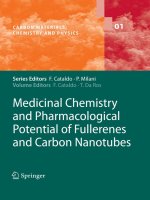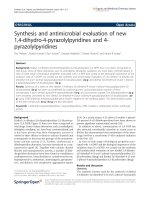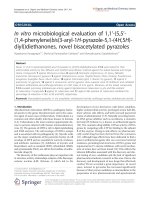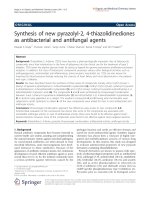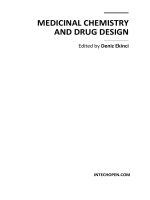Bioorganic medicinal chemistry lclaude spino; marco dodier; subramaniam sotheeswaran anti HIV coumarins from calophyllum
Bạn đang xem bản rút gọn của tài liệu. Xem và tải ngay bản đầy đủ của tài liệu tại đây (160.27 KB, 4 trang )
BIOORGANIC&
MEDICINAL CHEMISTRY
LETTERS
Bioorganic & Medicinal Chemistry Letters 8 (1998) 3475-3478
Pergamon
ANTI-HIV COUMARINS FROM CALOPHYLLUM SEED OIL
Claude Spino, *a Marco Dodier, a and Subramaniam Sotheeswaran b
aUniversit~ de Sherbrooke, D~partement de Chimie, 2550 Boul. UniversitY, Sherbrooke, Qc, Canada J1K
2R1. bSchool of Pure and Applied Sciences, The University of the South Pacific, Suva, Fiji
Received 10 July 1998; accepted 21 October 1998
Abstract: The seeds of Calophyllum cerasiferum Vesque (Family - Clusiaceae), and Calophyllum inophyllum
Linn. (Family - Clusiaceae) contain several known coumarins, among which were the potent HIV reverse
transcriptase inhibitors costatolide and inophyllum P. Calophyllum cerasiferum contained (-)-calanolide B as its
major coumarin constituent in significant amount and thus constitute a renewable source of this compound.
© 1998 Elsevier Science Ltd. All rights reserved.
Calanolide A (1) and costatolide (2) belong to a new class of HIV-1 reverse transcriptase inhibitors. 1,2 The
former has been designated for preclinical trials by the U.S. National Cancer Institute, while its isomeric
analogue, 2, is retained as an alternative for drug development. 3 Other pyranocoumarins such as soulattrolide 4
isolated from the latex of certain Calophyllum species were found to be active against HIV. 3 Acquiring
sufficient quantities of 1 for preclinical and clinical development presented a colossal problem since only minute
amounts (<1 mg/g extract) of calanolide A could be isolated from the leaves of Calophyllum lanigerum var.
austrocoriaceum. 4 Since this original source of (+)-calanolide A was destroyed, 5 finding new sources of active
pyranocoumarins has become a worthwhile endeavour. In 1994, researchers at NCI reported on the isolation of
pyranocoumarins with known anti-HIV activity from the latex of the tropical rainforest tree Calophyllum
teysmannii vat. inophylloide .3 Harvesting the latex, a renewable source, can be non destructive for the trees
and thus presented hope of getting adequate supply of costatolide. Costatolide represented 48% of the
extractable from the latex, but the approximate weight of extractable per unit weight of latex was not given.
Recently, total syntheses of optically active caianolide A and B have appeared in the literature. 6
I
0
0
O
O
.°~
(+)-Calanolide A 1
(-)-Calanolide B 2 (Costatolide)
0960-894X/98/$ - see front matter © 1998 Elsevier Science Ltd. All rights reserved.
PH."S0960-894X(98)00628-3
C. Spino et al./Bioorg. Med. Chem. Lett. 8 (1998) 3475-3478
3476
We surveyed the anti-HIV activity of a number of extracts from the seeds of several Calophyllum, and
other, species acquired in Fiji and surrounding Polynesian isles. Two crude extracts (hexanes) displayed marked
anticytophatic activity against HIV-I IIIB strain from 10 ktg/mL concentration in C8166 cells. One of the
samples, namely a seed extract from Calophyllum cerasiferum Vesque (Family - Clusiaceae) 7 contained (-)calanolide B (costatolide). NMR, mass spectrometry, and optical rotation confirmed the structure of the isolated
compound. Over 7 mg/g of extract were obtained and purification was straightforward using normal flashchromatography on a silica gel column (partition between hexanes and methanol to remove triglycerides and
other lipids, then chromatography using hexanes/10% EtOAc). This means that 1 Kg of crushed seeds, which
yielded 55 g of crude extract, yields nearly 0.4 g of pure costatolide.
Figure 1 gives an example of the anticytophatic activity of the crude extract from Calophyllum cerasiferum
containing costatolide. Small amounts of two unidentified coumarins were also present in this extract. They
could be easily separated from costatolide but were isolated as a mixture difficult to analyse. They are thought
to belong to the inophyllolide family as judged from the NMR and mass spectra.
100
O
:=,
80
m
60
m
40
m
20
I
I
I
I
I
I
I
I
I
-4
-3
-2
-1
0
1
2
3
4
Log [extract] (~tg)
Figure 1. Anti-HIV activity of crude extract of Calophyllum cerasiferum in an ELISA-based in vitro assay
(HIV- 1 p24 antigen) of cytopathicity of HIV- 1 IIIB strain to C8166 cells.
C. Spino et al. / Bioorg. Med. Chem. Lett. 8 (1998) 3475-3478
3477
The other active sample was shown to contain more pyranocoumarins than the previous one. The sample
originated from Calophyllum inophyllum Linn. (Family - Clusiaceae). 8 Calophyllolide 3 was the major
compound and several inophyUolides including inophyllum B (5), C (6), P (4), and E (7) were identified. We
presume that the anti-HIV activity was due to the presence of soullatrolide (inophyllum p),3,9 although two
more related compounds could be seen but were found in such small quantities that their identification has not
been possible so far. Calophyllolide, inophyllum C and E could be freed from other coumarins (90-95% purity)
while inophyllolides B and P were isolated as a mixture and identified from their respective proton NMR
signals.
I
h
..... y
4 Inophyllum P
(Soullatrolide)
3 Calophyllolide
5 Inophyllum B
"OH
6 Inophyllum C
7 Inophyllum E
The finding that Calophyllum seed oil contains HIV reverse transcriptase inhibitors, especially costatolide,
represent a significant progression in the search for renewable sources of these pyranocoumarins. Harvesting
the seeds is non destructive for these plants that grow abundantly in Fiji Islands. Seed oil from Calophyllum
inophyllum has been used in folk medicine to treat aching joints and rheumatism. 8 Although, we have found
that this extract was cytotoxic, that from Calophyllum cerasiferum was not at the highest concentration tested
(50 Izg/mL).
Acknowledgements: We thank the Universit6 de Sherbrooke and the University of the South Pacific for
financial support. We are indebted to Dr. R. D6ziel and his colleagues at BioM6ga/Boehringer Ingelheim
Research Inc. (Canada) for carrying out the anti-HIV assays.
3478
C. Spino et al. / Bioorg. Med. Chem. Lett. 8 (1998) 3475-3478
References and Notes
1. Kashman, Y.; Gustafson, K. R.; Fuller, W. R.; Cardellina, J. H.; McMahon, J. B.; Currens, M. J.; Buckheit,
R. W.; Hughes, S. H.; Cragg, G. M.; Boyd, M. R. J. Med. Chem. 1992, 35, 2735.
2. Boyer, P. L.; Currens, M. J.; McMahon, J. B.; Boyd, M. R.; Hughes, S. H. J. Virology 1993, 67, 2412.
3. Fuller, W. R.; Bokesch, H. R.; Gustafson, K. R.; McKee, T. C.; Cardellina, J. H.; McMahon, J. B.; Cragg,
G. M.; Soejarto, D. D.; Boyd, M. R. Bioorg. Med. Chem. Lett. 1994, 4, 1961.
4. Cardellina, J. H.; Bokesch, H. R.; McKee, T. C.; Boyd, M. R. Bioorg. Med. Chem. Lett. 1995, 5, 1011.
5. Flavin, M. T.; Rizzo, J. D.; Khilevich, A.; Kucherenco, A.; Sheinkman, A. K.; Vilaychack, V.; Chen, L. L.
W.; Greenwood, E. M.; Pengsuparp, T.; Pezzuto, J. M.; Hughes, S. H.; Flavin, T. M.; Cibulski, M.;
Boulanger, W. A.; Shone, R. L.; Xu, Z.-Q. J. Med. Chem. 1996, 39, 1303.
6. Deshpande, P. P.; Tagliaferri, F.; Victory, S. F.; Yan, S.; Baker, D. C. J. Org. Chem. 1995, 60, 2964.
7. Parham, J. W. Plants of the Fiji Islands; Authority of the Government of Fiji: Suva, 1972.
8. Whistler, W. A. Polynesian Herbal Medicine; National Tropical Botanical Garden: Hong Kong, 1992. p.
129-130.
9. Gulakowski, R. J.; McMahon, J. B.; Staley, P. G.; Moran, R. A.; Boyd, M. R. J. Virol. Methods 1991, 33,
87.
